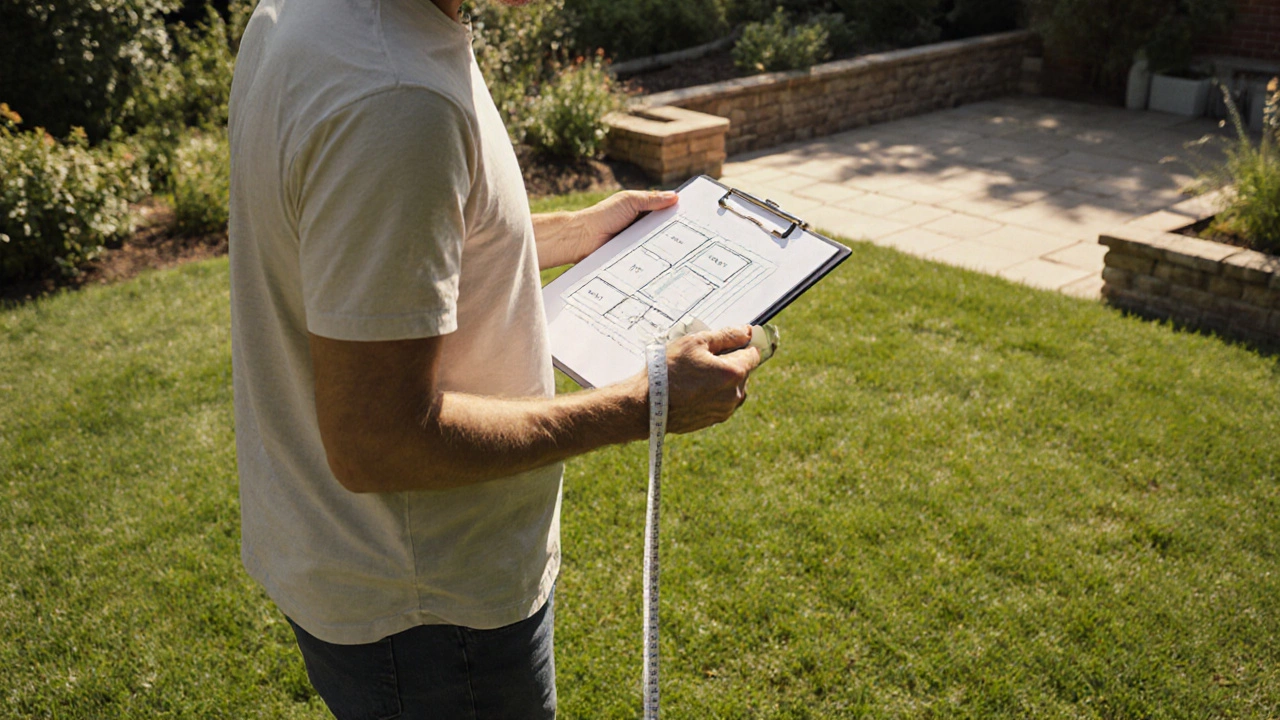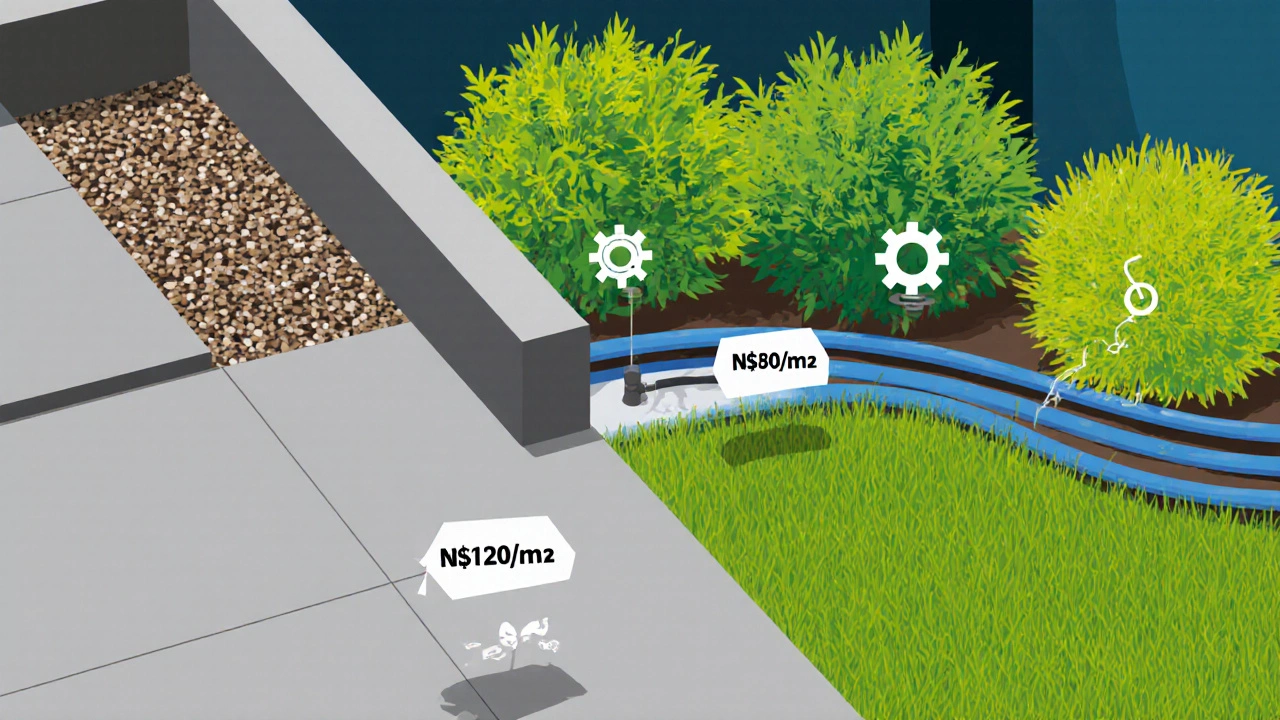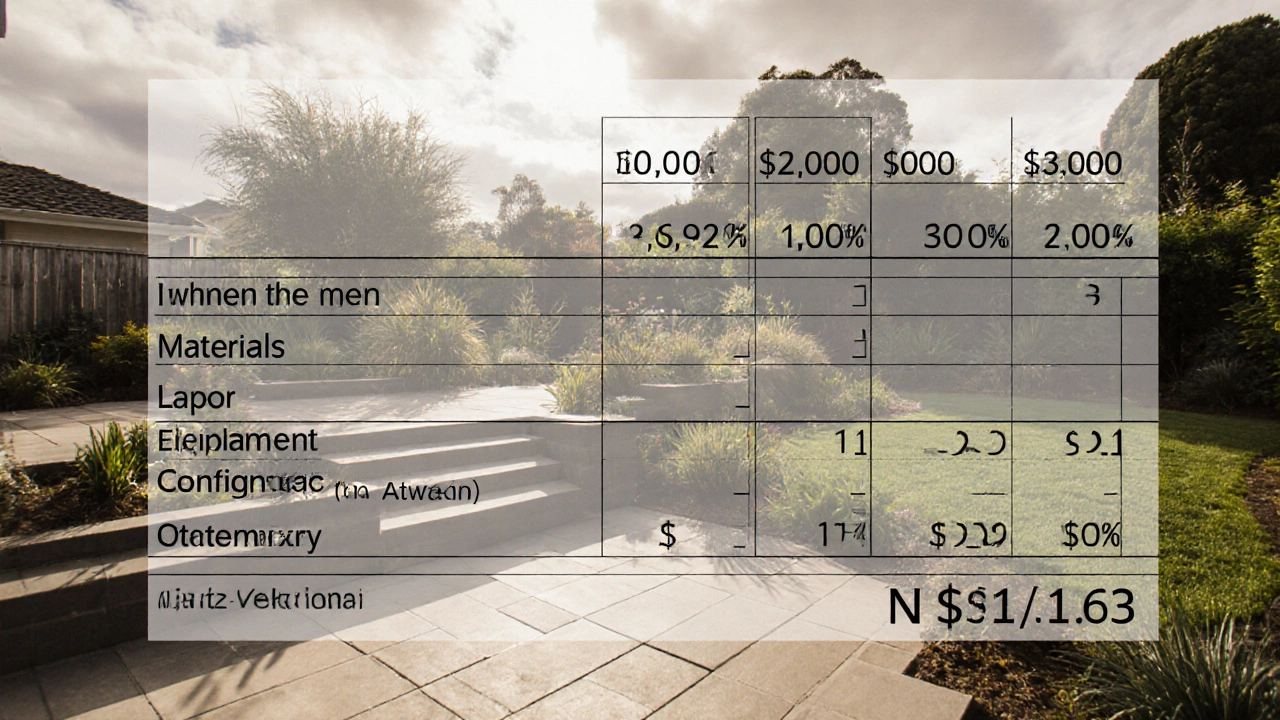Landscaping Cost Calculator: Step-by-Step Guide to Estimate Your Project Budget
 Oct, 20 2025
Oct, 20 2025
Landscaping Cost Calculator
Project Details
Hardscape Elements
Softscape Elements
Labor Rates (NZ$)
Budget Summary
Breakdown by Component
When you start planning a garden makeover, the biggest question is usually, “How much will this actually cost?” Calculating landscaping costs doesn’t have to be a guessing game. By breaking the project into clear pieces-size, materials, labor, and hidden fees-you can build a realistic budget that matches your vision and your wallet.
Key Takeaways
- Identify every cost component: design, hardscape, softscape, labor, permits, and contingency.
- Measure your area accurately; use square metres (m²) as the base unit.
- Apply average material rates for your region (NZ$ per m²) and adjust for quality.
- Factor in labor rates, crew size, and equipment rentals.
- Add a 10‑15% contingency to cover unexpected site conditions.
Understanding the Cost Building Blocks
Landscaping projects are a mix of hardscape-the non‑living elements like patios, retaining walls, pathways, and decks- and softscape-the plants, soil, mulch, and turf that bring life to the space. Each of these categories has its own price drivers.
Beyond materials, you’ll spend on design fees (often a percentage of total cost), excavation and grading, drainage solutions, irrigation systems, and required permits. Labor, which includes the crew’s hourly wages and equipment use, usually represents 30‑50% of the total budget.
Gathering the Right Project Data
Before you can plug numbers into a calculator, you need solid data:
- Site dimensions: Measure length and width of each area you plan to treat. Multiply to get square metres (m²).
- Topography: Note slopes, existing structures, and any obstacles like trees or utility lines.
- Design complexity: Simple lawn replacement vs. multi‑level garden with water features.
- Location specifics: In Wellington, the climate means you’ll often choose wind‑tolerant, salt‑resistant plants, which can affect plant costs.
Calculating Material Costs
Material prices vary by quality and supplier, but average ranges for New Zealand are a good starting point. Below is a quick reference table you can use in your spreadsheet.
| Material | Low‑end | Mid‑range | High‑end |
|---|---|---|---|
| Concrete patio | 120 | 180 | 250 |
| Retaining wall (block) | 150 | 220 | 300 |
| Gravel pathway | 50 | 80 | 110 |
| Native shrubs | 30 | 55 | 90 |
| Turf (sod) | 35 | 55 | 80 |
| Irrigation system | 40 | 70 | 110 |
To estimate, multiply the square metres of each material by the chosen price tier. For example, a 20 m² concrete patio at the mid‑range rate (NZ$180) costs 20 × 180 = NZ$3,600.

Estimating Labor and Equipment
Labor rates depend on the trade and the region. In Wellington, typical hourly rates are:
- General labourer: NZ$30‑35
- Carpenter/craftsman (for decks, retaining walls): NZ$45‑55
- Landscape specialist (planting, irrigation): NZ$40‑50
Calculate crew hours by estimating how many hours each task will take. A useful rule‑of‑thumb is:
- Excavation & grading: 0.5‑1 hour per m²
- Hardscape installation: 1‑2 hours per m² (depends on complexity)
- Softscape planting: 0.2‑0.5 hour per plant
- Irrigation layout: 0.3‑0.7 hour per m²
Don’t forget equipment rentals-mini‑excavators, compaction plates, and concrete mixers can add NZ$80‑150 per day.
Adding Contingency and Overhead
Even the best‑planned projects hit unexpected snags: hidden water pipes, soil that needs more amendment, or a sudden rise in material prices. Adding a contingency buffer protects you from budget blow‑outs.
Guideline:
- Simple lawn replacement: 10% contingency
- Mixed hard‑/softscape with grading: 12‑15% contingency
- Complex designs with custom features: 15‑20% contingency
Apply the percentage to the subtotal of material + labor before taxes.
Sample Calculation: A 100 m² Garden in Wellington
- Define scope: 40 m² patio (mid‑range concrete), 30 m² retaining wall (block), 30 m² planting area (native shrubs and turf).
- Material costs:
- Patio: 40 m² × NZ$180 = NZ$7,200
- Retaining wall: 30 m² × NZ$220 = NZ$6,600
- Native shrubs: 20 m² × NZ$55 = NZ$1,100
- Turf: 10 m² × NZ$55 = NZ$550
- Irrigation (30 m²): 30 m² × NZ$70 = NZ$2,100
Subtotal materials = NZ$17,550
- Labor estimate:
- Excavation (100 m² × 0.7 h) = 70 h × NZ$35 = NZ$2,450
- Concrete work (40 m² × 1.5 h) = 60 h × NZ$45 = NZ$2,700
- Retaining wall (30 m² × 1.8 h) = 54 h × NZ$45 = NZ$2,430
- Planting (30 plants × 0.3 h) = 9 h × NZ$40 = NZ$360
- Irrigation install (30 m² × 0.5 h) = 15 h × NZ$40 = NZ$600
Subtotal labor = NZ$8,540
- Equipment rental: Mini‑excavator for 2 days = NZ$200; concrete mixer 1 day = NZ$80. Total = NZ$280.
- Design & permits: 5% of material + labor = 0.05 × (NZ$17,550 + NZ$8,540) = NZ$1,304.
- Contingency (12%): 12% × (NZ$17,550 + NZ$8,540 + NZ$280 + NZ$1,304) = NZ$3,489.
- Final budget: NZ$17,550 + NZ$8,540 + NZ$280 + NZ$1,304 + NZ$3,489 ≈ NZ$31,163.
This example shows how each line item adds up. Adjust any number-material grade, labour hours, or contingency-to fit your actual project.

Tips to Keep Costs Down Without Sacrificing Style
- Phase the work: Do the hardscape first, then add planting in a second phase when you have a clearer budget.
- Use native, fast‑growing plants: They require less water and maintenance, lowering long‑term expenses.
- Recycle on‑site material: Re‑use excavated soil after proper testing, or repurpose old paving stones.
- Get multiple quotes: A 10% price spread is common; choose a contractor with proven local experience.
- Design for DIY: Simple mulch beds or seed‑ed turf can be installed by homeowners, saving labour costs.
Common Pitfalls and How to Avoid Them
Under‑estimating excavation: Soft, water‑logged soils need extra removal time and possibly drainage solutions. Always have a geotechnical survey for large slopes.
Skipping permits: In Wellington, certain retaining walls over 1 m high require a building consent. Ignoring this can lead to fines and re‑work.
Ignoring irrigation design: An inefficient system can waste water and raise operating costs. Plan zones and consider drip irrigation for planting beds.
Frequently Asked Questions
How do I measure my garden for a cost estimate?
Measure the length and width of each distinct area, then multiply to get square metres. Sketch a simple plan or use a free app like SketchUp to visualize zones.
What is a realistic contingency percentage?
For most residential projects, add 10‑15% of the subtotal (materials + labour). Complex sites with slope or old infrastructure should budget up to 20%.
Do I need a professional designer?
A designer isn’t mandatory, but a 5‑10% design fee can prevent costly mistakes and improve the final look. Many designers offer a 2‑hour consultation for a flat rate.
How much does irrigation typically add to the budget?
A basic drip system runs around NZ$70‑110 per square metre, including tubing, emitters, and controller. Smart controllers add a few hundred dollars but can cut water use by 30%.
Can I reuse soil from excavation?
Yes, if the soil is free of contaminants and properly screened. Test for pH and compaction, then amend with compost before re‑using.
By following this structured approach, you’ll turn an intimidating estimate into a clear, actionable budget. Whether you’re a DIY homeowner or hiring a professional crew, a well‑calculated figure sets realistic expectations and protects you from hidden costs.
